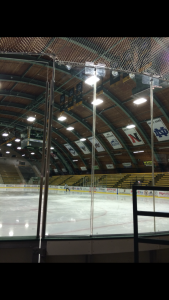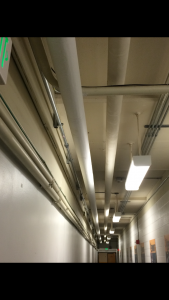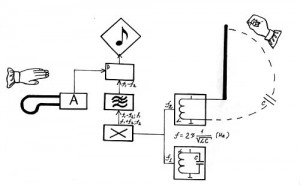R. Murray Schafer, the author of the article “The Soundscape”, advocates for the importance of sound appreciation around the world. Certainly, the world is an ever-changing place, so we have to pay attention to these changes to better understand the sounds around us. Our group finds UVM to have an extremely unique soundscape unlike any that we have ever experienced. UVM has an excessive amount of keynote sounds, or notes that identify the key or tonality of a particular composition. Keynote sounds do not have to be listened to consciously; they are overheard but cannot be overlooked, for keynote sounds become listening habits in spite of themselves. (Schafer 100). The wind, birds, insects, traffic noises and urban sounds are always overheard in our conscious audio field but never overlooked. Signals we hear around campus (foreground sounds that are listened to consciously) like the voices, phrases, and songs we hear daily, are all so unique to this school and cannot be experienced anywhere else. All of our experiences working in the Patrick Gymnasium and listening to its soundscape proves the importance of sound in a unique soundscape setting unlike any that we have ever experienced. All three members of our group were overwhelmed by the diversity and quantity of sounds being produced inside the Patrick Gym. Each section of the gym, whether it was the ice rink, weight room, or swimming pool, has a unique soundscape differing from one another while all being inside the same building.
During Noah’s soundwalk, he experienced an abundance of sounds being produced from the gym that were each unique to the area of the gym he was in. Starting off near the recreational studio and working his way towards the main lobby, the sounds of soft steps, metal lockers shutting, the removal of clothing, and the opening of doors to the main lobby all flooded the echoey cement hallway. During this sound walk, Noah found it interesting that the sounds were difficult to hear if his body was not still. He found that if he was trying to listen and walk at the same time, the acoustics of his body became keynote sounds and would almost always overpower the soundscape in his surrounding vicinity. Although his personal movements overpowered the surrounding sounds, this was not the case for when he sat and observed an ice hockey practice. The crashes and claps of the puck in the rink synchronizing with the skates gliding roughly on ice overpowered every sound in the area and overpowered his own movements proving that different sections of the gymnasium have different impacts on the level of sound being produced.
It is difficult to say which sounds are important to the gymnasium’s soundscape due to the fact that each section of the gym holds unique sounds important to that specific area. If you had to generalize the entire gym, the attribute to describe the collection of sounds produced from the Gym would fall under the category of an echo. The cement construction of the building allows sound, no matter what form of audio being produced, to travel and echo throughout. While the auditory action of the echo sounds seemed to dominate the gymnasiums soundscape, another keynote sound in the gym would have to be the mechanical sounds including but not limited to the pipes, vents, and electrical work running along the perimeter as well as the interior of the building. The constant buzzing/ hums throughout the gym’s interior are similar to the human heartbeat: always present, but not always felt/ heard. The sounds of different sports being played simply layer themselves over the most fundamental of sounds in the gymnasium: the mechanics. They identify the key parts of the gym and are extremely difficult to duplicate, thereby proving it to be a keynote sound.
Verbal sounds produced by people on this site, rather than machinery or actions, may offer a different perspective to the gym’s aural identity and offer encouragement and the continuation of those sounds. During Charlotte’s field observation in the pool, she noticed that the splash of the water and movement in the pool coupled with encouragement from other teammates amplified as each team member began to swim faster. Charlotte noticed a strong, positive correlation between verbal encouragement and physical performance. In essence, the swimmers swam quicker when the room was louder. The soundscape, amplified with the sounds of motion and movement, proves that certain sounds affect the interactions at the site. Matt noticed this as well when analyzing his field observation in the tennis court but in the opposite manor. While the players became increasingly more focused on the game, their vocal and aggressive manor diminished with each serve, and the sounds in the court decreased with the levels of concentration increasing. Both Matt and Charlotte expressed that the volume (whether that be loud or quiet) filled the room and became the dominant sound, experiencing sonic dominance in different ways throughout the Patrick Gym. The observation involving sonic dominance our group experienced can relate to Lawrence English’s statement interpreting sonic dominance as, “[a guide] to generate a specific particular sense of place rather than a general abstract idea of space. It’s as if the sound itself becomes both a source and expression of this power. (459)” This statement, provided by English, explains Matt and Charlotte’s observation in the gym, proving that certain verbal sounds on this site encourage either audio growth or decay and sonically dominate the surrounding vicinity.
All three members of our group have gained a newfound appreciation for the aural identity of the University of Vermont soundscape, especially the soundscape enclosed inside the Patrick Gymnasium. Each member of our group was able to experience something new and compelling, intriguing each of us to want to continue listening to the unique aural identity of the gym. We all found it so fascinating how there are so many levels to the gyms aural identity, and surpassed our expectations of the amount of sounds and acoustic motion that is present in the gym. While each member of our group experienced something different inside the gym, whether that be the sonic dominance of different sounds or even the sonic dominance of silence, we all were able to agree that the gym took on an aural identity of its own, sometimes producing certain compositions over which we have no control or showing that we are composers and responsible for its identity. So, “The final question will be: is the soundscape of the world an indeterminate composition over which we have no control, or are we its composers and performers, responsible for giving it form and beauty?” (96 Schafer)
Author Archives: Matt Jackson
Theremin
Southern Comfort
When I first read the instructions for the audiography, my first instinct was to think “eh… I’ll do that later” because I had absolutely no idea where to start. There are so many sounds I hear throughout my day that I do not even think twice about, so how can 10 of these sounds hold any importance or value to me? A few days passed by and the assignment was still looming over my head. I realized that any time I would try and think about this project, I would distract myself by walking away from my desk to a more comfortable space. That is when it dawned on me that my audiography had to be centered on the theme of comfort.
No matter how upset or angry I may be, I will always dance and rap along to some of my favorite songs; it is the only stimuli that can instantly change my mood. For this reason, the first sound in my audiography is a recording of Meek Mill and Drake’s song “RICO”, which I use as the alarm on my phone to wake myself up every morning. Provided that I grew up just outside of Philadelphia, hip-hop has always been a big part of my life. Listening to rap music definitely reminds me of home and helps wake me up in the morning.
After I get up from bed, I make my way down the hall towards the showers. The white noise of the water quickly rushing out of the shower head and eventually hitting my body provides the perfect environment for me to clear my mind and forget about anything that is stressing me out.
Although I love music and showers, my morning would not be complete without a cup of coffee. The sound of my Keurig making coffee is included in the audiography because it represents the true start of my day. Without coffee, my brain is mush.
Coffee in hand, I make my way over to the bus stop. The next sound is a recording from the inside of the Redstone Express. Listening to people talk on the bus and hearing the squeaks and creeks of the busses reminds me of taking the bus to school every day back at home, which is definitely a comforting reminder of life in PA.
When I am all finished with my classes, I make my way back to Redstone via the Ankle Express (walking). When I make it out of the tunnel by the Davis Center, I am met with a long stretch of quiet, lonely land. This absence of sound is important to me because it is one of the only times throughout my day where I can get some time away from people and noise for a little.
I inevitably end up snacking when I get home from a long day of school, so I included the sound of a wrapper crackling in my audiography. Of course, food is an extremely comforting substance that everyone enjoys. As a result, it is obvious why I included it in a recording of comforting sounds.
Once I am done with my snack, there is nothing I want to do more than to just sit back and hang out with my friends. For this reason, I decided to include the sounds of video games playing because that is typically where we all migrate to in order to forget about the day.
When I was younger, I was always taught the importance of eating dinner together as a family. Similarly at UVM, I always make sure to bring my friends with me to dinner so we can all eat and talk together. The loud chatter of students in Simpson certainly reminds me of my family talking around the dinner table back at home.
Once dinner is finished, the worst part of the day pulls around: homework time. I always listen to music while doing homework because, as i mentioned earlier, hip-hop music is extremely comforting to me because of the memories that are tied to the songs and culture. As a result, my second to last sound is the scratching of my pen against paper as I am doing homework. Young Thug’s “Check” is also playing in the background.
The last sound that I decided to include in my audiography is the click of my bedside lamp as I turn it off for the night. When I hear this noise, I instantly calm down knowing that the day is finally over and that I can get some rest.
Similar to Barthes’ analysis of “The Grain”, or the idea that people are heavily influenced by music, I feel like there is a grain to everyday life. Sure, not all sounds contain words that can be interpreted/ understood, but they nevertheless change our feelings and perception of the world around us. I believe that the comforting sounds I chose for my audiography are a fair and accurate representation of what I believe my grain in life is at UVM.
Works Cited:
Barthes, Roland. “The Grain of the Voice.” (1997): 179-89.
Williams, Robert Rihmeek, and Aubrey Drake Graham. R.I.C.O. Meek Mill Ft. Drake. Vinylz, 2015. Youtube. Web. 4 Oct. 2015.
Williams, Jeffrey Lamar. Check. Young Thug. London on Da Track, 2015. Youtube. Web. 5 Oct. 2015.
Sounds:
- RICO by Meek Mill ft. Drake
- Shower
- Keurig Machine
- Redstone Express
- Quiet walk back to Redstone
- Sound of plastic wrapper crackling
- Playing video games
- Dinner at Simpson
- Check by Young Thug plays while I’m writing in Sharpie on paper (hw, start at 2:17)
- Sound of me turning off my light next to my bed



